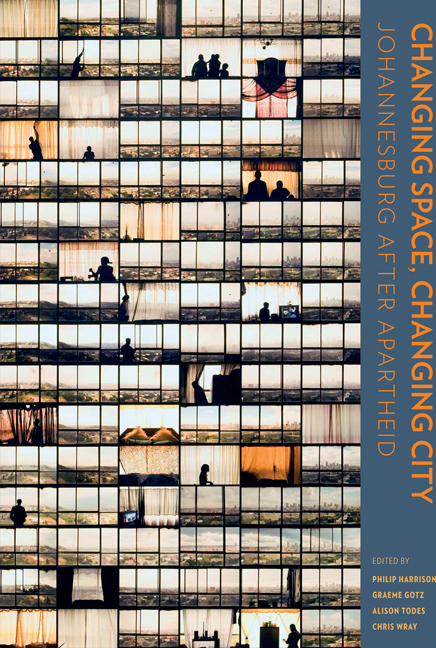Book contents
- Frontmatter
- Contents
- Preface
- Cartography
- 1 Materialities, subjectivities and spatial transformation in Johannesburg
- Section A The macro trends
- Section B Area-based transformations
- 12 Between fixity and flux: Grappling with transience and permanence in the inner city
- 13 Are Johannesburg's peri-central neighbourhoods irremediably ‘fluid’? Local leadership and community building in Yeoville and Bertrams
- 14 The wrong side of the mining belt? Spatial transformations and identities in Johannesburg's southern suburbs
- 15 Soweto: A study in socio-spatial differentiation
- 16 Kliptown: Resilience and despair in the face of a hundred years of planning
- 17 Alexandra
- 18 Sandton Central, 1969–2013: From open veld to new CBD?
- 19 In the forest of transformation: Johannesburg's northern suburbs
- 20 The north-western edge
- 21 The 2010 World Cup and its legacy in the Ellis Park Precinct: Perceptions of local residents
- 22 Transformation through transportation: Some early impacts of Bus Rapid Transit in Orlando, Soweto
- Section C Spatial identities
- Contributors
- Photographic credits
- Acronyms
- List of plates
- List of figures
- List of tables
- Index
12 - Between fixity and flux: Grappling with transience and permanence in the inner city
from Section B - Area-based transformations
Published online by Cambridge University Press: 20 April 2018
- Frontmatter
- Contents
- Preface
- Cartography
- 1 Materialities, subjectivities and spatial transformation in Johannesburg
- Section A The macro trends
- Section B Area-based transformations
- 12 Between fixity and flux: Grappling with transience and permanence in the inner city
- 13 Are Johannesburg's peri-central neighbourhoods irremediably ‘fluid’? Local leadership and community building in Yeoville and Bertrams
- 14 The wrong side of the mining belt? Spatial transformations and identities in Johannesburg's southern suburbs
- 15 Soweto: A study in socio-spatial differentiation
- 16 Kliptown: Resilience and despair in the face of a hundred years of planning
- 17 Alexandra
- 18 Sandton Central, 1969–2013: From open veld to new CBD?
- 19 In the forest of transformation: Johannesburg's northern suburbs
- 20 The north-western edge
- 21 The 2010 World Cup and its legacy in the Ellis Park Precinct: Perceptions of local residents
- 22 Transformation through transportation: Some early impacts of Bus Rapid Transit in Orlando, Soweto
- Section C Spatial identities
- Contributors
- Photographic credits
- Acronyms
- List of plates
- List of figures
- List of tables
- Index
Summary
Restless city
How to upgrade and regenerate an inner-city environment where nothing is permanent but not everything is transient either? This seems to be the dilemma facing the City of Johannesburg Metropolitan Municipality. Does it rebuild an inner city that caters for a transient population and transient activities or does it rebuild it based on an assumption that greater stability is needed and that permanence is a legitimate aspiration? It seems that these choices lie at opposing ends of a continuum that the municipality has battled to position itself on when planning its interventions in the ever-changing spaces of the inner city.
Since pre-colonial times what is now the centre of Johannesburg has been the site of entering and leaving, staying put and moving on – a constant shift between transience and permanence. From the comings and goings of successive tribes of BaTswana, BaSotho and Matabele (Brodie 2008), to the arrival of Dutch settlers, to the appearance of prospectors, tradesmen and mine labourers – it has been a place of entry and exit, place-making and displacement, sett ling and struggling, a place where very little stays constant but some come to stay. Throughout these comings and goings, the spaces of the central city have played a number of different roles, some of which have been permanent while others have been transient and fleeting responses to the temporal and socio-political context of the day.
The bricks and mortar (or corrugated iron and timber) of the area we know as the inner city were put in place over the past 124 years. Each layer of the city's physical fabric successively represents a spatial form that tried to suit the function of the day, but the physical make up of the buildings signify only a small part of their story. The inner city has played multiple roles through time and is still required to fulfil many competing, simultaneous agendas. This dynamism has been matched by an inconsistent, fluctuating and at times incoherent governance response. Rapid spatial change as a result of social, economic and political forces has exacted a considerable toll on the state. The question of how to design, plan, manage, in some cases ‘control’ and maintain this space in flux has plagued city administrators since 1886.
- Type
- Chapter
- Information
- Changing Space, Changing CityJohannesburg after apartheid, pp. 232 - 251Publisher: Wits University PressPrint publication year: 2014



